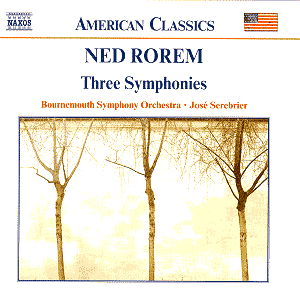Ned Rorem was born in Richmond, Indiana on 23
October 1923. His teachers included Wagenaar, Honegger and Virgil
Thomson. From 1949 to 1957 he moved to France. As composer-in-residence
at the Universities of Buffalo and Utah commissions and performing
opportunities came his way. His five movement Third Symphony
was written in April 1958 in New York. In his programme notes
for the work he writes that the work was "entirely thought up
and written down in a three week period during the last of seven
summers at the chateau of the Vicomtesse de Noailles in Hyères
which I miss to a point of anguish and may never see again."
When Jose Serebrier writes, in his programme
notes, that the Utah Symphony LP recording of the work (Turnabout
TV-S34447) was not transferred to CD he is wrong. In 1994 Vox
issued VoxBox 11 60212 which included both the Rorem and its LP
companion, Schuman's Seventh, together with Siegfried Landau's
superb version of the Hanson Sixth Symphony - the latter having
six movements to the Rorem's five. The Rorem work has nothing
of greyness about it. Its idiom fits without undue comfort within
the bounds set by Harris, Hanson, Poulenc, Ravel and Diamond (as
in the Fourth Symphony). The work has a dreamy, languid, strolling
quality lifted by the intemperate almost roistering brassiness
of the two allegro movements (II and V). The yawing bell-like
slow swing of the first movement is picked up in the seething
confidently joyful singing action of the finale. Bernstein, who
premiered the piece on 16 April 1959, must have loved it. Such
a shame he did not add it to his roster of American symphony recordings
to join Thompson 2, Diamond 4 and Schuman 3. Mind you the same
could be said of another work, stronger I think than the Rorem,
the Hanson Sixth. How does the Serebrier fare against the 1970s
Abravanel version? For a start the acoustics are better by miles.
The only real downside technically speaking is that the brass
have artificially vivid impact in the Vox version which is missing
in the Naxos disc. Serebrier bustles just as much as Abravanel
in both allegros (II and V) and captures superbly the dreamy nostalgia
of the largo and 'palely loitering' andante. These movements (III
and IV) have a dream-filmic quality which is rendered with additional
amplitude and plangency in Naxos's fully digital sound.
The First Symphony is in a more conventional
four movements. It is lithe and flowing, contented, bathed in
April sunshine, idyllically self-communing through the flute and
oboe solos in the largo and light-hearted in the final allegro.
The first movement was written in New York in 1948 and the remaining
three in Morocco eighteen months later. It is good to have this
high spirited yet sensitive symphony at last in good sound rather
than having to rely on the tape from which I first heard the piece
- an aircheck of a 1950s broadcast by the National Gallery Orchestra
conducted by Richard Bales.
The three movement Second Symphony was
written in 1956 in New York City at the commission of Nikolai
Sokoloff who conducted the premiere in La Jolla (the very
place for which Martinů wrote
his Sinfonietta of the same name). This is a work in which darker
shadows appear - darker than both its companions. It seems to
swirl and has some sharply defined rhythmic effects in the Americana
tradition of Schuman (those snare drum rimshots again!)
as well as some lovely melodic effects as at 8.03 in the long
first movement. The second movement, a Tranquillo, touches
on the same heartland as the andantino and the largo
of the First Symphony. This nostalgic mood is shared with such
core Americana as Hugo Friedhofer's score for The Best Years
of Our Lives and sections of Barber's Knoxville. The
final allegro ruffles and bustles along with touches of
Roy Harris (3 and 7) - a sort of Stateside equivalent of the last
movement of Moeran's Sinfonietta. Once again this disc
now happily replaces my stressed cassette of a broadcast by the
CBC Vancouver Symphony conducted by Charles Avison.
This disc has the same collectors' symmetry as
the Naxos Creston disc which also has that composer's first three
symphonies.
These are not thunderously protesting symphonies
but neither are they trivial lightweights. Rorem's compass takes
in nostalgia, joyous athletic activity and a certain tenderness
of expression all couched in language without dissonance but always
rife with the flavour of originality.
Rob Barnett
